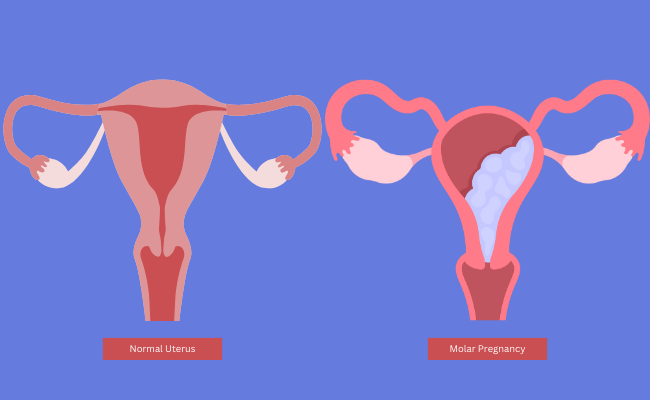How to Treat Molar Pregnancy?
- January 09, 2024
- No Comments

What is Molar Pregnancy?
Molar pregnancy, or hydatidiform mole, is an uncommon condition where improper fertilization leads to the formation of a noncancerous tumor resembling water-filled sacs. This abnormal growth prevents the development of a viable embryo, often requiring surgical removal. Left untreated, molar pregnancies can result in serious complications. They are classified under gestational trophoblastic disease (GTD), also known as hydatidiform moles.
Why Molar Pregnancy Occurs?
The occurrence of molar pregnancy is rooted in chromosomal abnormalities that happen during fertilization. In a complete molar pregnancy, the egg lacks its genetic material, and the sperm duplicates its chromosomes, leading to an abnormal and non-viable combination. In partial molar pregnancies, two sperm fertilize a single egg, resulting in an extra set of chromosomes. These chromosomal abnormalities disrupt the normal development of the embryo and placenta, giving rise to a molar pregnancy.
How Molar Pregnancy Manifests
Signs and Symptoms:
- Vaginal Bleeding: Molar pregnancies often present with vaginal bleeding, which can be mistaken for a miscarriage. This bleeding may be more significant than typical early pregnancy bleeding.
- Rapid Uterine Growth: Due to the presence of the abnormal tissue, the uterus may grow at an abnormal rate, leading to a larger size than expected for the gestational age.
- Severe Nausea and Vomiting: Women with molar pregnancies may experience extreme nausea and vomiting, a condition known as hyperemesis gravidarum. This severe morning sickness can be a notable symptom.
- High Blood Pressure or Preeclampsia: Molar pregnancies can sometimes lead to elevated blood pressure or the development of preeclampsia, a serious pregnancy complication characterized by high blood pressure and damage to other organs.
- Elevated hCG Levels: Blood tests may reveal abnormally high levels of human chorionic gonadotropin (hCG), a hormone produced during pregnancy. Elevated hCG levels are a significant marker for molar pregnancies.
Diagnostic Procedures:
- Ultrasound: A crucial diagnostic tool, ultrasound helps visualize the uterus and detect the presence of abnormal tissue. A characteristic "grape-like" cluster of cysts is often observed in molar pregnancies.
- Blood Tests: Measurement of hCG levels in the blood is conducted to monitor the progression of pregnancy and assess for abnormalities. In molar pregnancies, hCG levels are typically much higher than expected for the gestational age.
Treatment Solutions
- Evacuation of the Uterus: The primary and most common treatment for molar pregnancy is the evacuation of the abnormal tissue from the uterus. This is typically performed through a suction dilation and curettage (D&C) procedure. The goal is to promptly remove the molar tissue, preventing potential complications.
- Follow-up Monitoring: After the evacuation, close monitoring of hCG levels is crucial. Elevated or plateaued hCG levels post-treatment may indicate persistent molar tissue or the development of gestational trophoblastic disease (GTD).
- Chemotherapy: In cases where there is evidence of persistent molar tissue or the development of GTD, chemotherapy may be recommended. Methotrexate, a chemotherapy drug, is commonly used to target rapidly dividing cells, including abnormal trophoblastic tissue.
- Avoiding Pregnancy: Women are advised to postpone pregnancy for a certain period following treatment to allow for adequate monitoring and to minimize the risk of recurrence. Contraception methods are often recommended during this time to prevent unintended pregnancies.
Benefits of Timely Treatment
- Prevention of Complications: Timely evacuation of the molar tissue is crucial for preventing complications such as persistent trophoblastic disease or the development of choriocarcinoma, a rare but aggressive cancer. Early intervention is key to addressing the immediate health concerns.
- Emotional and Physical Recovery: Swift treatment allows for emotional healing and physical recovery. The emotional toll of a molar pregnancy can be significant, and prompt intervention supports the grieving process. Providing support and counseling during this period is essential for the well-being of the affected individuals.
- Preventing Choriocarcinoma: Choriocarcinoma is a rare cancer that can develop from persistent molar tissue. Early detection and treatment significantly reduce the risk of this serious complication. Timely and appropriate management contribute to a positive prognosis.
- Monitoring Future Pregnancies: Women who have experienced a molar pregnancy may require closer monitoring during future pregnancies to ensure a healthy and successful outcome. Early detection of any potential issues allows for proactive management and reduces the risk of recurrence.
- Emotional Support: Timely treatment enables healthcare providers to offer emotional support to women and couples affected by molar pregnancy. Counseling and support groups can be beneficial in navigating the emotional challenges associated with this condition. Providing a supportive environment is crucial for the mental well-being of those going through this difficult experience.
Comments (0)